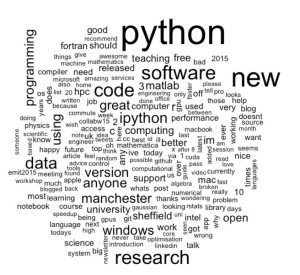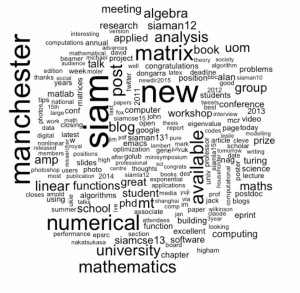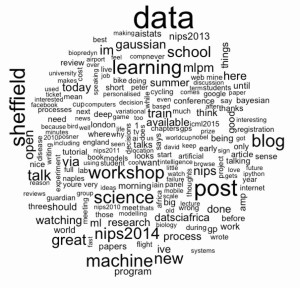Archive for November, 2015
A recent trend on Facebook is to create a wordcloud of all of your posts using an external service. I chose not to use it because I tend to use Facebook for personal interactions among close friends and I didn’t want to send all of my data to another external company.
Twitter is a different matter, however! All of the data is open and it’s very easy to write a computer program to generate Twitter world clouds without the need for an external service.
I wrote a simple script in R that generates a wordcloud from the most recent 3200 tweets and outputs the top 200 words (get the code on github). The script removes many of the uninteresting words such as the, of, and that would otherwise dominate the cloud. These stopwords come from the Top100Words list of the R package qdap but I also added a few more such as ‘just’ and ‘me’ that I seem to use a lot.
This is the current wordcloud for my twitter account, walkingrandomly. Click on the image to see a bigger version. My main interests are very clear – Python programming, research software, data and anything that’s new!
Once I had seen my wordcloud, I wondered how things would look for other twitter users who I pay a lot of attention to. This is how it looks for Manchester University’s Nick Higham. Clearly he’s big on SIAM, Manchester, and Matrix Analysis!
I then looked at my manager at Sheffield University, Neil Lawrence. Neil finds data and the city of Sheffield very important and also writes about workshops, science, blog posts and machine learning a lot.
The R code that generated these wordclouds is available on github but it won’t work out of the box. You’ll need to register with twitter for app development (It’s free and fairly straightforward) and get various access keys before you can use the code.
Welcome to the 128th Carnival of Mathematics, the latest in a mathematical blogging tradition that’s been ongoing for over 8 years now!
Facts about 128
It’s said that every number is interesting and 128 is no exception. 128 is the largest number which is not the sum of distinct squares whereas it is the smallest number n such that dropping the first and the last digit of n leaves its largest prime factor (thanks, Number Gossip).
Wikipedia tells us that it is divisible by the total number of its divisors, making it a refactorable number. Additionally, 128 can be expressed by a combination of its digits with mathematical operators thus 128 = 28 – 1, making it a Friedman number in base 10.
128 was also the number of kilobytes of memory available in the magnificent computer shown below.
The Princeton Companion to Applied Mathematics
I recently received a copy of the The Princeton Companion to Applied Mathematics and it’s just beautiful, definitely recommended as a christmas gift for the maths geek in your life. The companion’s editor, Nick Higham, has written a few blog posts about it – Companion authors speaking about their work, Famous Mathematicians and The Princeton Companion and How to Use The Princeton Companion to Applied Mathematics.
We have a lot of problems, and that’s a good thing
‘Diane G’ submitted this advanced knowledge problem — great practice for advanced mathematics. This blog is amazing and posts practice problems every Monday and advanced problems every Wednesday.
Linear Programming
Laura Albert McLay of Punk Rock Operations Research (great blog title!) submitted two great posts: Should a football team run or pass? A game theory and linear programming approach and dividing up a large class into discussion sections using integer programming
Francisco Yuraszeck submitted 10 Things You need to know about Simplex Method saying ‘This article is about the basics concepts of Linear Programming and Simplex Method for beginers in Operations Research.‘
Computation
Stuart Mumford demonstrates various ways of computing the first 10,000 numbers in the Fibonacci Sequence using Python — and some are much faster than others. Laurent Gatto followed up with a version in R.
Cleve Moler, the original developer of MATLAB, looks at three algorithms for finding a zero of a function of a real variable:
- Zeroin, Part 1: Dekker’s Algorithm
- Zeroin, Part 2: Brent’s Version
- Zeroin, Part 3: MATLAB Zero Finder, FZERO
Michael Trott of Wolfram Research looks at Aspect Ratios in Art: What Is Better Than Being Golden? Being Plastic, Rooted, or Just Rational? Investigating Aspect Ratios of Old vs. Modern Paintings
Andrew Collier explores Fourier Techniques in the Julia programming language.
Optimisation
The Numerical Algorithm Groups’s John Muddle looks at solving The Travelling Rugby Fan Problem.
Robert Fourer gives us two articles on Quadratic Optimization Mysteries: Part 1 and Part2. These are posts concerned with computational aspects of mathematical optimization, and specifically with the unexpected behavior of large-scale optimization algorithms when presented with several related quadratic problems.
Why Was 5 x 3 = 5 + 5 + 5 Marked Wrong
This image went viral recently

It generated a LOT of discussion. Brett Berry takes a closer look in Why Was 5 x 3 = 5 + 5 + 5 Marked Wrong.
Misc
Katie Steckles submitted an article that analyses the different visual themes explored by M.C. Escher in his artwork
Shecky R writes about our curious fascination with eccentric and top-notch mathematicians in Pursuing Alexander.
Brian Hayes has been Pumping the Primes and asks “Should we be surprised that a simple arithmetic procedure–two additions, a gcd, and an equality test–can pump out an endless stream of pure primality?”
Next time
Carnival of Maths #129 will be delivered by the team at Ganit Charcha. Head over to the main carnival website for more details.





